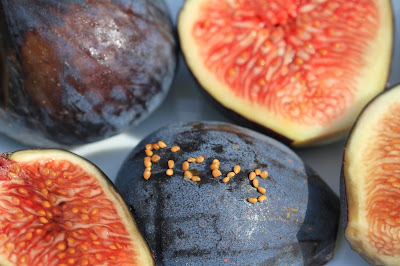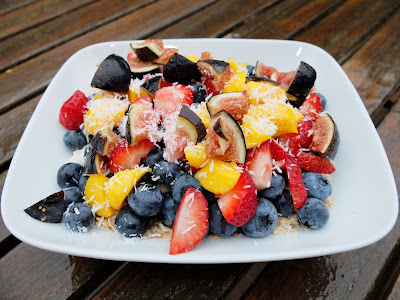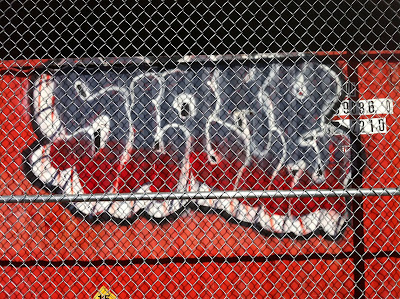Left: Hike Profile KML from Canon GPS Logger; Right: View of Tomyhoi Lake
Hike Notes
Length: 12.3 miles (according to *Garmin HCX)
Duration: 8.25 hours (8:15 am – 4:30 pm)
Elevation Gain: 4,361 (total), 6,184 ft max elevation on top of Yellow Aster Butte*, starting @ 3,670 ft
Location: North Cascades – Mount Baker Highway
For our sixth hike of the 2014 summer (and bringing us to 84.8 total miles this season), we chose Yellow Aster Butte (WTA: Yellow Aster Butte, Tomyhoi Lake). We actually went to Tomyhoi lake first and then Yellow Aster Butte. At approximately 1.4 miles from the trailhead, the trail splits and you make your choice: the left route takes you to Yellow Aster Butte, and the right route takes you up over Gold Run Pass and down to Tomyhoi Lake. The path to Yellow Aster Butte is well-beaten and easy to follow. The path to Tomyhoi Lake was bit trickier, we lost it a few times as we busied ourselves with flower pictures. Nearer to the lake, there were many paths to get to the lake edge and you just had to pick one. The lake elevation is close to starting elevation at the trailhead. It’s quite a slog to climb back out to Gold Run Pass.
On the Yellow Aster Butte trail, we encountered a lot of people. Saturday, sunshine, beautiful views, and trail popularity explains it. Not many seem to opt for the Tomyhoi Lake trail, which we found very quiet. Choose wisely.
Selected Plants Observed
Format: [Family] Genus species (Common Name). Links are to WTU Image Collection.
[Asteraceae] Petasites frigidus (Sweet Coltsfoot) – “Petasites is from the Greek petasos ‘a broad-brimmed hat,’ referring to the large basal leaves characteristic of this genus.” [1]
[Liliaceae] Anticlea occidentale (Mountainbells)
[Melanthiaceae] Veratrum viride (Green False Hellebore)
[Orobanchaceae] Castilleja parviflora (Mountain Indian Paintbrush)
[Orobanchaceae] Pedicularis racemosa (Sickletop Lousewort)
[Onagraceae] Chamerion angustifolium (Fireweed)
[Onagraceae] Chamerion latifolium (Broad-Leaved Willowherb)
[Orchidaceae] Platanthera stricta (Slender Bog Orchid)
[Orchidaceae] Goodyera oblongifolia (Western Rattlesnake Plantain)
[Phrymaceae] Erythranthe lewisii (Purple Monkey-Flower). Given as Mimulus lewisii in [1].
[Phrymaceae] Erythranthe guttata (Seep Monkey-Flower). Given as Mimulus guttatus in [1].
[Polygonaceae] Oxyria digyna (Alpine Mountain-Sorrel)
[Ranunculaceae] Anemone occidentalis (Western Pasqueflower)
[Rosaceae] Potentilla flabellifolia (High Mountain Cinquefoil)
[Rosaceae] Rubus spectablis (Salmonberry)
[Saxifragaceae] Leptarrhena pyrolifolia (Leatherleaf Saxifrage)
[Saxifragaceae] Micranthes tolmiei (Tolmie’s or Alpine Saxifrage)
Insects Observed
Pterostichus (Beetle)
Pterophoroidae (Plume Moth)
Pointania californica (Willow Apple Gall Sawfly) Gall [2]
Polygonia[3] (Angel-Winged Butterfly) on Valerian
Speyeria hydaspe? [3] (Hydaspe Fritillary)
References
[1] Plants of the Pacific Northwest Coast: Washington, Oregon, British Columbia & Alaska
[2] http://bugguide.net/node/view/185043/bgimage
[3] On the checklist for Whatcom County from ButterfliesAndMoths.org.
Left: Plume Moth on Goodyera oblongifolia, near trailhead; Right: Dew drops on Moss, near Tomyhoi Lake
Left: Angel-Winged Butterfly, on the way to Yellow Aster Butte; Right: Fritillary on Veratrum leaf
Left: Pterostichus Beetle Near Tomyhoi Lake; Right: Potentilla flabellifolia
Left: Sawfly Gall; Right: Larva Inside Gall
Left: Anemone occidentalis (Western Pasqueflower); Right: Anticlea occidentale (Mountainbells)
Left: Castilleja parviflora (Mountain Indian Paintbrush); Right: Leptarrhena pyrolifolia (Leatherleaf Saxifrage), both in the wet meadow above Tomyhoi Lake
Fireweeds. Left: Chamerion angustifolium; Right: Chamerion latifolium
Monkey-Flowers. Left: Erythranthe lewisii (Purple Monkey-Flower); Right: Erythranthe guttata (Seep Monkey-Flower)
Left: Micranthes tolmiei (Tolmie’s or Alpine Saxifrage); Right: Oxyria digyna (Alpine Mountain-Sorrel)
Left: Platanthera stricta (Slender Bog Orchid) – near Tomyhoi Lake and smelled like honey!; Right: Valerian Feathery Seed Heads
Left: Veratrum viride (Green False Hellebore) Single Flower; Right: Rubus spectablis (Salmonberry) Single Berry
Left: Map at Trailhead to Yellow Aster Butte and Tomyhoi Lake; Right: View from Gold Run Pass toward Mt. Larrabee and the American Border Peak



%2Bon%2BValerian.JPG)


.JPG)


.JPG)
.JPG)
.JPG)

.JPG)
.JPG)
.JPG)
.JPG)
.JPG)
.JPG)
2.JPG)
.JPG)
.JPG)

%2BFlower.JPG)
.JPG)







































